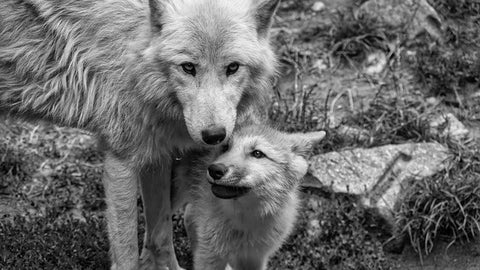
BARF diet: feeding your dog like a wolf, a good idea?
of reading - words
When it comes to dog nutrition, the BARF (Bones and Raw Food) diet is often discussed. The idea is to feed your dog as naturally as possible, inspired by the diet of wild wolves . But is it really a good idea? We explain everything you need to know about this method, which promises optimal health and renewed vitality for your dog.
What is BARF feeding?
The BARF diet is more than just a trend. Its origins date back to the 1990s, when Australian veterinarian Ian Billinghurst proposed this raw-food diet. The idea is simple: to return to a diet that mimics the diet of our domestic dogs ' canine ancestors .
Origins and concept of the BARF diet
The concept of BARF is based on the idea that dogs, just like their wild cousins, thrive best when fed raw meats , bones , organs , and sometimes fruits and vegetables . Essentially, it's about returning to a more natural and less processed diet than kibble or industrial pâtés. The diet typically consists of:
- Raw meat (muscle, offal)
- Bones (uncooked to avoid dangerous splintering)
- Fruits and vegetables (for vitamins and fiber)
- Supplements (such as omega-3 rich oils)
This diet aims to mimic the diet of wolves, who hunt and consume a variety of raw foods. The theory is that this more natural diet could offer significant benefits in terms of health , digestion , and vitality for our dogs.

Why compare BARF to the diet of wild wolves?
Wolves are the wild ancestors of our domestic dogs. By observing their diet, we can learn a lot about what might be optimal for our companions. Here are some reasons why the BARF diet is often compared to the diet of wild wolves:
Raw Food : Wolves do not consume processed food. They feed on whole prey, which provides a natural balance of nutrients .
Dietary Variation : Like wolves, dogs fed the BARF diet receive a variety of foods. This includes animal protein , bones for calcium, and plants for fiber and vitamins.
Dental health : Wolves, thanks to their natural diet, generally have excellent teeth. The BARF diet aims to replicate this effect by providing chewable bones, which help clean teeth and strengthen jaws.
Energy and Vitality : Wolves are active animals with robust health . The BARF diet aims to replicate this effect by providing a diet that supports high energy metabolism and good overall health .
To learn more about wolves, you can consult these articles:
The Benefits of BARF Diet for Dogs
The BARF diet is often touted for its many potential benefits. By feeding your companion like a wolf, you can provide them with incredible health . Let's take a closer look at why this diet is considered beneficial by its proponents.
Optimal health, like wolves
One of the main reasons the BARF diet is appealing is the idea of replicating the health of wild wolves. Wolves, as natural predators, possess robust health and impressive longevity thanks to their varied, raw diet. By feeding our dogs a similar diet, we aim to provide them with similar benefits.
For example, studies show that dogs fed raw , natural foods can benefit from improved dental health , better body condition , and reduced chronic disease . By returning to a diet more similar to that of wolves , dog owners hope to replicate these beneficial effects seen in the wild.
Nutritional benefits: raw meat and bones for healthy teeth
The BARF diet is often praised for its nutritional benefits , particularly the quality of the raw meat and bones used. Raw meat provides high-quality protein and essential fatty acids , which are essential for muscle development and skin health . Bones, on the other hand, are a natural source of calcium and phosphorus , which are crucial for maintaining strong teeth and a robust skeleton .
Dogs fed BARF often have cleaner teeth and fewer dental problems because chewing on bones helps remove tartar and stimulate gums . Additionally, raw meat and bones promote healthy digestion by providing nutrients in their most natural form.
Improved digestion and immune system
One of the most frequently mentioned benefits of the BARF diet is improved digestion and immune system . Raw food is easier for dogs to digest because it is not subject to industrial processing that alters its nutritional properties. This means that nutrients are better absorbed, which can contribute to better digestive health and a reduction in gastrointestinal problems .
Additionally, the BARF diet is rich in natural vitamins and minerals , which can boost your dog's immune system . The nutrients in raw meat and fresh vegetables help support essential bodily functions, prevent infections , and maintain overall good health .
The link between BARF and shiny fur: the example of wild wolves
One of the most visible outward signs of a dog's health is the quality of its coat . Wolves, with their natural diet, have a dense, shiny coat, often envied by dogs. Adopting the BARF diet can help improve the appearance of your dog's coat in a similar way.
Essential fatty acids found in raw meats and oils added to the BARF diet can contribute to a shinier coat , fewer skin problems , and reduced shedding . Owners who have adopted BARF often report a visible improvement in the quality of their dog's coat, making it healthier and shinier .

The disadvantages and risks of BARF feeding
Despite the many benefits often touted, the BARF diet is not without its risks and drawbacks . It is essential to be aware of these before deciding if this diet is right for your dog. Here are the main aspects to consider.
The dangers of raw meat: bacteria and parasites
One of the main drawbacks of the BARF diet is the potential risk of contamination by bacteria and parasites . Raw meat can be a source of pathogens like Salmonella and Campylobacter , which can be dangerous for dogs, especially young puppies, older dogs, or those with weakened immune systems.
In addition to bacteria, raw meat can contain parasites such as worms or protozoa . These parasites can cause digestive problems and require veterinary treatment to eliminate. To minimize these risks, it is crucial to choose high-quality meat sources, freeze meat thoroughly before feeding it to your dog (to kill parasites), and maintain strict hygiene when preparing meals.
Nutritional imbalances: a risk for domestic dogs
Another potential drawback of the BARF diet is the risk of nutritional imbalance . Although BARF aims to mimic the diet of wolves, it can be difficult to provide a perfectly balanced diet that meets the specific needs of each dog. Raw meat and bones, while helpful, are not always enough to cover all the vitamin , mineral , and essential fatty acid requirements.
Nutritional deficiencies can lead to various health problems, such as bone disorders , skin problems , or metabolic disorders . To avoid these imbalances, it is important to follow the recommendations of a veterinarian or canine nutritionist and ensure appropriate variation of ingredients.
Cost and logistics: feeding your dog like a wolf, at what cost?
The BARF diet can also be a bit of a budget-buster. High-quality raw meat, bones, and supplements can be expensive , especially if you have a large dog or multiple pets. The cost can quickly add up, making BARF less affordable for some dog owners.
In addition to the cost, preparing BARF meals requires careful planning . You must purchase, store, prepare, and serve raw ingredients, which takes time and effort. It's also important to ensure food is stored properly to avoid contamination. For some, these aspects can be significant obstacles to implementing the BARF diet.
BARF Myths: Debunking the Myths
Finally, it's important to deconstruct some preconceived ideas about the BARF diet. Here are some common myths :
“ Raw meat makes dogs aggressive ” : This myth is unfounded. There is no solid scientific evidence linking raw meat to aggressive behavior in dogs.
“ Raw bones are dangerous for dogs ” : Contrary to popular belief, raw bones, when given properly, can be beneficial for teeth and digestion. Cooked bones, on the other hand, can splinter and cause obstructions or perforations.
“ BARF is not suitable for dogs with special needs ” : Although some dogs with special dietary needs require adjustments, the BARF diet can be adapted for these cases with proper veterinary supervision.
Alternatives to BARF feeding
While the BARF diet has its supporters, there are several alternatives for those looking for different feeding options for their dog. Whether you're concerned about the logistics of BARF or want to try other options, here are three popular alternatives to consider.
Fresh meals for dogs
Fresh dog meals are an increasingly popular alternative to the BARF diet. Unlike raw dog food, which you have to prepare yourself, fresh dog meals are usually prepared by specialist brands and delivered ready-to-eat. These meals are often designed to provide a balanced and nutritious diet tailored to each dog's specific needs.
A great example of such meals is Elmut , which offers high-quality options for your four-legged friends. Elmut Fresh Dog Meals are made from fresh, natural ingredients, without artificial preservatives or additives, and are tailored to various nutritional needs. These meals can offer a quality alternative to BARF, while ensuring your dog receives a complete and balanced diet.
Dry food (kibble)
Dry food , or kibble, is one of the most common and convenient options for feeding dogs. Kibble is often formulated to provide balanced nutrition and is available in a wide variety of formulations suited to different ages, sizes, and nutritional needs of dogs. It is also easy to store and serve, making it accessible to busy owners.
Kibble can be high-quality when made with quality ingredients, such as premium animal proteins and whole grains . However, it's important to choose reputable brands and check labels to avoid products containing additives or inferior by-products .
Wet food
Wet dog food , often in canned pâté form, is another alternative to BARF feeding. It is generally more palatable to dogs due to its texture and aroma. Wet food can also be beneficial for dogs that need extra hydration , as it contains a high proportion of water.
As with kibble, it's essential to choose high-quality wet food. The best products contain quality meat or fish, vegetables , and healthy grains . It's also essential to check that the wet food provides complete and balanced nutrition , without excess sodium or other unwanted ingredients.
How to properly implement BARF feeding for your dog?
Adopting the BARF diet for your dog can offer many benefits, but it requires careful and methodical implementation. Here are the essential steps to successfully transition to this type of diet and ensure the well-being of your four-legged friend.

Preliminary steps: consultation with the veterinarian and analysis of needs
Before starting the BARF diet, it is crucial to consult your veterinarian . Your veterinarian can help you assess whether this diet is suitable for your dog's specific health and needs. Depending on your dog's age, weight, activity level, and any pre-existing medical conditions, your veterinarian can provide you with personalized recommendations.
During this consultation, it's also helpful to discuss your dog's nutritional needs analysis . Every dog is unique, and a balanced diet must be tailored to their individual needs. A needs analysis may include blood tests or other assessments to ensure BARF isn't likely to cause deficiencies or imbalances.
Choosing the right ingredients: quality first
The success of the BARF diet depends largely on the quality of the ingredients used. To provide your dog with truly beneficial nutrition, choose fresh , unprocessed meats, as well as quality bones and organs . Look for meat sources from reliable producers and avoid products that may contain additives or preservatives.
Vegetables and fruits added to the BARF diet should also be fresh and properly prepared. Make sure they are cut into small pieces or chopped to aid digestion. When it comes to supplements, if necessary, choose products specifically designed to complement BARF diets, such as omega-rich oils or vitamin supplements .
The ideal proportions: taking inspiration from wolf meals
The ideal proportions for a BARF diet should be inspired by the natural diets of wolves, while also being adapted to the modern needs of domestic dogs. Generally, a good balance consists of:
- 70% meat (including meaty cuts and offal)
- 10% bones (uncooked to avoid the risk of fractures)
- 10% vegetables (such as carrots, zucchini, and spinach)
- 10% fruit (such as apples or berries)
It is important to follow these proportions to avoid nutritional imbalances and ensure your dog receives a complete and varied diet. Following these ratios helps provide all the nutrients needed to maintain good health and optimal physical condition .
Adapt BARF to the size and activity of the dog
Every dog has different nutritional needs depending on its size , age , and activity level . A growing puppy, an active adult dog, and a senior dog will have different dietary needs.
For a puppy , it may be necessary to increase the proportions of meat and calories to support rapid growth. A very active adult dog may require a higher amount of protein and fat to maintain energy levels. On the other hand, a senior or less active dog may require a lower calorie diet to avoid weight problems.
It is therefore crucial to adjust portions and types of ingredients according to your dog's specific needs, and to regularly monitor his body condition and energy levels to adjust the diet as needed.
Avoiding Common Mistakes: What Wolves Would Never Eat
When introducing BARF feeding, it's important to avoid some common mistakes many owners make. Here are some things to avoid:
- Do not feed cooked meat : Cooked bones can splinter and cause obstructions or perforations. Feed raw bones and make sure they are appropriate for your dog's size.
- Avoid dairy products : Dogs cannot digest lactose properly, and dairy products can cause digestive upset.
- Do not add condiments : Spices, salt, and other condiments are inappropriate for dogs and can cause health problems.
- Don't forget vegetables and fruits : Although meat is the main ingredient, vegetables and fruits provide essential vitamins and fiber for a balanced diet.
What do experts say about BARF feeding?
When considering switching your dog to a BARF diet, it's essential to seek expert advice to make the right decision. Here's what some leading animal nutrition experts have to say.
Dr. Ian Billinghurst , veterinarian and author of the book on BARF, explains: " The BARF diet, when properly balanced, can provide excellent nutrition for dogs. It closely mimics the natural diet of canine predators, which can improve the overall health of pets. However, it requires a thorough understanding to avoid nutritional imbalances " (source: Dr. Ian Billinghurst, "Give Your Dog a Bone" ).
Dr. Lisa Freeman , professor of animal nutrition at Tufts University, notes, " The benefits of BARF often include improved skin and coat condition, as well as improved digestion. However, it is crucial that owners educate themselves and consult a veterinarian to avoid potential risks related to deficiencies or contamination " (source: Dr. Lisa Freeman, "Nutrition for Dogs and Cats" ).
Dr. Patrick Mahaney , a veterinarian specializing in integrative medicine, warns, “ BARF can be a great option for some dogs, but it comes with logistical and nutritional challenges. Owners must be knowledgeable and willing to tailor the diet to their pet’s specific needs. Regular veterinary monitoring is essential to ensure the dog’s health and well-being ” (source: Dr. Patrick Mahaney, “The Holistic Dog” ).
Finally, is the BARF diet a good solution for all dog breeds?
The BARF diet is not a one-size-fits-all solution for all dogs. Its suitability depends on several key factors, including the dog's breed, age, activity level, and overall health.
For healthy , active dogs, the BARF diet can offer significant benefits, including improved body condition , better digestion , and healthier skin . Sporting or working dogs can benefit from the high protein and fat content of BARF to maintain performance and energy.
However, for dogs with specific needs , such as older dogs, dogs with health problems, or those with special nutritional needs, the BARF diet can present challenges. The risks of nutritional deficiencies and imbalances must be carefully managed with the help of a veterinarian to avoid potential complications.
Small breeds and puppies also require special attention, as their nutritional needs may differ from those of adult and large dogs. The BARF diet can be adapted, but it must be carefully planned to meet their specific needs.
Do you enjoy the world of wolves ? Discover a wide range of products at the Terre des Loups store: wolf tattoos , wolf t-shirts , wolf jewelry , wolf pendants , and more...




